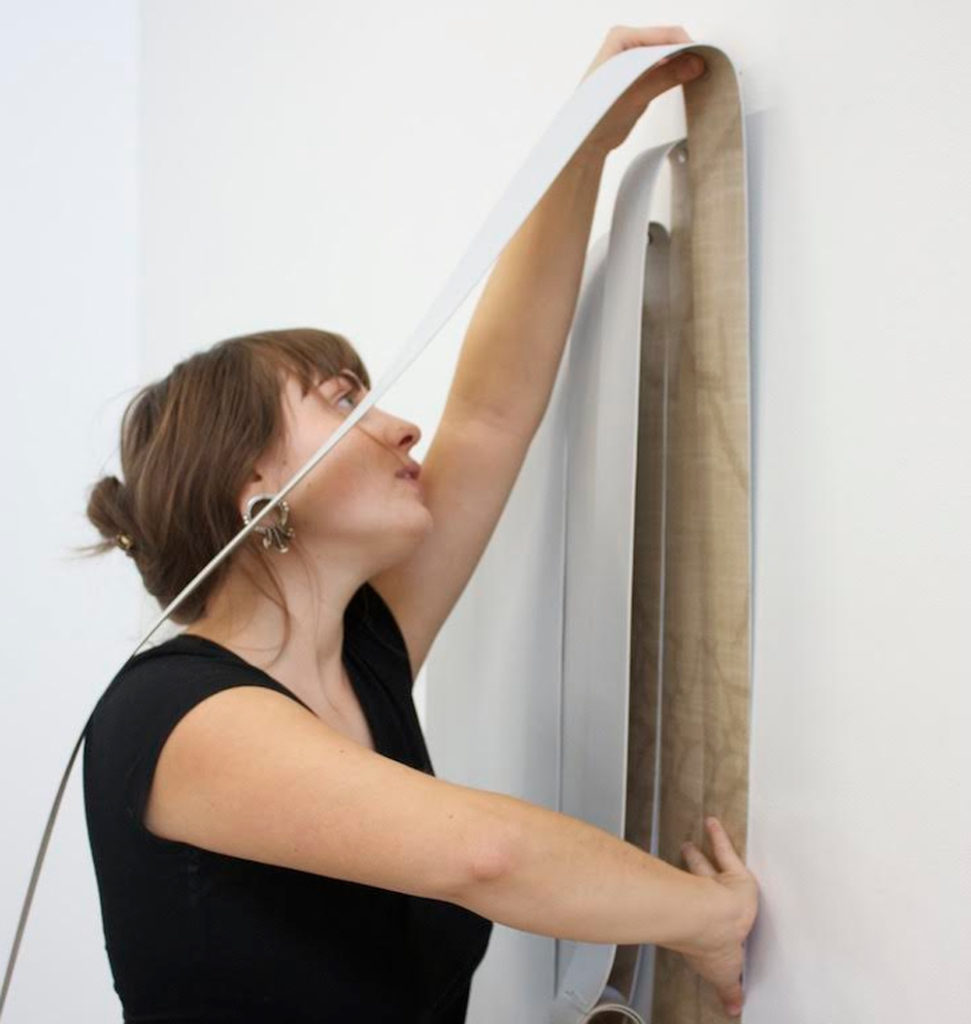Calgary artist Svea Ferguson makes evocative sculptures and wall works out of cut linoleum and vinyl, among other materials. Her work was recently highlighted in “Do it like the sun,” a project by Saskatoon’s AKA Artist-Run at Art Athina in Greece. Coming up, her art can be viewed in a solo show at the Ledge Gallery at Arts Commons in Calgary in December 2016, and also at the Alberta Biennial, which will debut in the summer of 2017 at the Art Gallery of Alberta. Here, Ferguson shares her favourite web finds of late.
For Every Word Never Written: The Library of Babel
This has to be one of the most incredible websites I have ever discovered. Based on an idea outlined in author Jorge Luis Borges’s essay “The Total Library,” and further elaborated in his short story “The Library of Babel,” Brooklyn-based programmer/writer Jonathan Basile has made Borges’s universal library a reality.
My extremely basic explanation of the Library of Babel is this: a database that contains every possible combination of every character (lower case alphabet, periods, commas and spaces) in existence; meaning that everything that has ever been written, or ever could be written, exists here in this library. It has a search function that allows you to search any combination of words up to 3,500 characters long; anything you could ever dream up already exists here in the library.
It even has a “physical” layout; hexagonal bookshelves, with each book assigned a volume, and each volume having 410 pages, and 40 lines per page. Any combination of words that you search for already has a place in a certain volume, on a specific page and line, and they will always be in that spot. I suggest you check out the Reference Hex to read more in depth about the philosophy and layout of the library before you delve in.
As friend of mine who showed me this site so aptly stated: It’s one of those things that once you know it exists, it changes your perspective forever. For example, my eulogy is in there waiting for me to (never) discover.
For All the Feels: We Feel Fine
All the feelings on this one! We Feel Fine is a website that gathers emotional data from the web. Every few minutes, the site’s algorithm searches the Internet for any instances of “feel” statements, and then logs this information on a visual map. The site boasts a database of several million human feelings, increasing by 15,000 to 20,000 new feelings per day.
There are six different ways to view the data on this site; my personal favourite is the “madness” view, where little dots float all over the page, each representing one instance of an individual posting an emotion on the web, roughly categorized by a colour that represents that emotion. If you catch a dot and click on it, it reveals the full sentence that was posted expressing that emotion. It’s a nice place to get lost online, the statements range from complete irrelevance to profound complexity. There is something here for (and from) everyone.
For Sticky Business: This to That
I discovered This to That during the first year of my undergrad, and it has come in handy more times than I can count. I’m not sure how many people know about its existence (it should be so popular!), but it’s a website where you can type in whichever two materials you want to glue together and it tells you all of the different adhesives that will create the best bonds. It is so great and basic and useful. Fun tip: Check out the Glue O’Month section (which hasn’t been updated since 2003).
For Visual Stimulation: Synaptic Stimuli
I don’t look at many visual-art blogs regularly, but this one came up on my radar a couple of years ago and has remained a fairly steady stop on my online travels. It is an all-visual blog (no essays here) that incorporates art images of all matters of making. The subcategories it provides for browsing are not typical; subjects like morphology, vibration and frequency sit alongside photography and sculpture. This one is worth checking out if you’re looking for some “hi-fidelity aesthetic stimulation.”
For Drawings for the 21st Century: Emma Kunz
Emma Kunz was a Swiss healer and researcher who was born in the late 1800s, and whose artistic work was not recognized until after her death in 1963. Kunz created large-scale, mandala-type geometric drawings on graph paper, each one directly referencing her research in healing, metaphysics and the connections between mind, body and spirit.
I discovered Kunz’s work many years ago, while I was making a series of repetitive geometric pattern drawings. I think it was probably looking at her work that made me realize my formalist approach to the drawings I was making was somewhat lacking, and that the drawings were not worth pursuing further (ha!), which in retrospect was certainly the right decision for me.
I continue to find her work inspiring, though, because of the theoretical way she approached her drawings. Each form and mark had deep meaning and specific association for Kunz, and I think that is an interesting approach to consider for any artist, including myself, regardless of one’s modes of making.

 Calgary artist Svea Ferguson is known for striking works in vinyl and linoleum, both large and small. Photo: Tamara Hart, Division Gallery.
Calgary artist Svea Ferguson is known for striking works in vinyl and linoleum, both large and small. Photo: Tamara Hart, Division Gallery.







